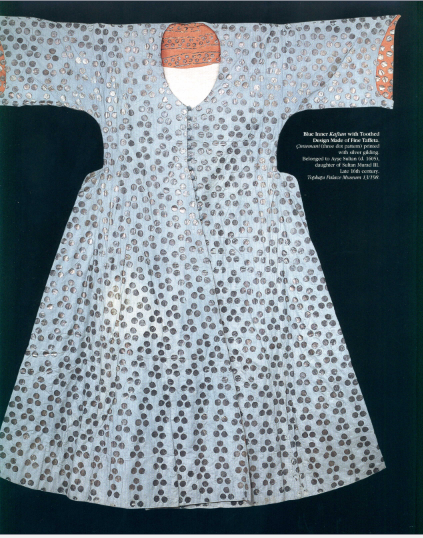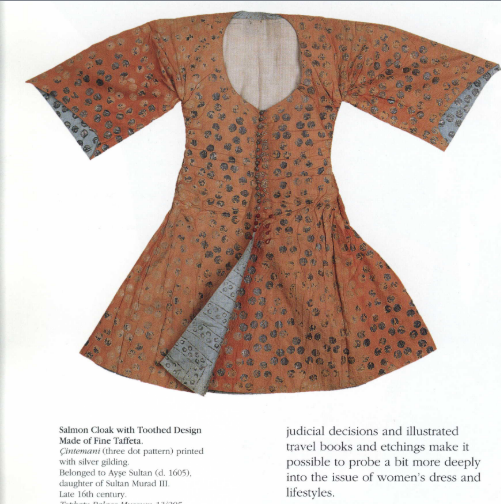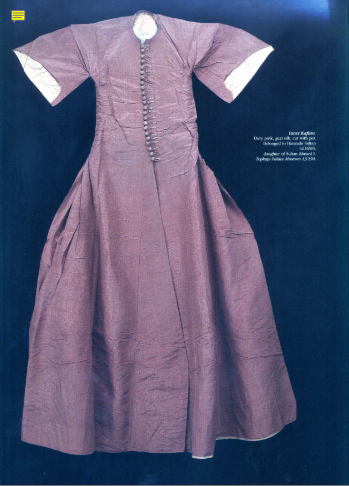In working on the book the last few weeks, I've spent a lot of time looking at extant Ottoman caftans and I thought I'd share a few of the lesser known ones with you.
The information and images about these caftans comes from:
Tezcan, Hülya. Fashion at the Ottoman Court: The Topkapi Palace Museum Collection. Istanbul: Raffi Portakal, Portakal Art and Culture House Organisation, 2000. Print.
This source also has excellent images of extant women's hats.
One of the challenges of working with extant garments is the uneven way that historical garments have been saved, conserved, studied and displayed. Women's garments, even the garments of royal women, are less often conserved and displayed.
So here are 3 extant Ottoman caftans. All 3 caftans were made for the daughters of Ottoman sultans. These garments were created for women who lived in the royal harem at the Topkapi Palace in Istanbul and that is where they have been conserved. They are identified as 'inner caftans', meaning they would have been worn over the gomlek (undergown), possibly in several layers based on the weather and the formality of the event. For formal occasions, an outer caftan of more precious fabric would have been worn as the final layer. And in bad weather, a ferace was worn as an overcoat.
The first two caftans were made for Ayse Sultan, who was the daughter of Sultan Murad III; she died in 1605
In addition to details of cut and patterning, what fascinates me is that both caftans were made from the same two lengths of cloth, one with the blue fabric as the main fabric and one with salmon.
I have no idea if these caftans were worn together or if the shorter salmon one was simply made up out of the remaining cloth leftover from the more formal blue one.
Another interesting thing is that the silver dots are not applied by weaving, applique or embroidery but instead by gilding. The gilding process is the same for silk as it is for paintings on paper and we have several examples of this process on pre-1600 garments in Europe as well as Asia.
So another question is: how common was this fabric? Did Ayse have the only two pieces or was this a more common pattern available either in the palace or more widely?
The third caftan was made for Hanzade Sultan, daughter of Sultan Ahmed I. She died in 1650. This pink silk caftan was also made in the standard Ottoman style.
I have no idea if these caftans were worn together or if the shorter salmon one was simply made up out of the remaining cloth leftover from the more formal blue one.
Another interesting thing is that the silver dots are not applied by weaving, applique or embroidery but instead by gilding. The gilding process is the same for silk as it is for paintings on paper and we have several examples of this process on pre-1600 garments in Europe as well as Asia.
So another question is: how common was this fabric? Did Ayse have the only two pieces or was this a more common pattern available either in the palace or more widely?
The third caftan was made for Hanzade Sultan, daughter of Sultan Ahmed I. She died in 1650. This pink silk caftan was also made in the standard Ottoman style.
There are also some interesting variations in cut, tailoring and possibly fit. The first two caftans were made for the same person. We don't know if they were made at the same time, just cut differently or if the garments were made separately as her body size and shape changed.
In addition to differences in length, the blue caftan has the 'bump out' shape at the top of the gores while the salmon one appears to have gores that are a simple triangle shape.
Both of Ayse's garments have front gores that appear to start in the general vicinity of the waist. The garment made approximately 50 years later for Hanzade has a front gore that extends to the neck. It isn't clear from the way it is folded and displayed if Hanzade's had 'bump out' or traditional gores.
The differences in gore style for both the front edge and the sides changes the way the garment fits and hangs as well as changing the silhouette by emphasizing or smoothing the hips.
Another interesting thing is that if you just glance at the most famous extant Ottoman caftans, it appears that all garments had huge pattern motifs. However, this style of weaving was very complex and very expensive so it was reserved for people of very high status at very formal occasions.
However, when you look at Ottoman paintings of figures where multiple layers of garments and many people of varying rank and it becomes apparent that the huge 'classically Ottoman' motifs were actually quite rare. Small motifs in the so-called 'international style' stayed fashionable, as did plain fabric and fabric with more subtle textured, stamped or woven effects.
If that whole rabbit-hole intrigues you, start with the exhibit catalog for The Sultan's Garden: the Blossoming of Ottoman art. The entire exhibit and book are dedicated to explaining the shift from small motifs to large as a deliberate strategy to create a 'brand for' the newly emerging Ottoman empire. Absolutely fascinating and I was lucky enough to attend the symposium and exhibit tour led by Walter Denney and Nurhan Atasoy.
https://museum.gwu.edu/sultans-garden-blossoming-ottoman-art
https://www.amazon.com/Sultans-Garden-Blossoming-Ottoman-Softcover/dp/0874050375/ref=sr_1_2?s=books&ie=UTF8&qid=1544883462&sr=1-2&keywords=sultan%27s+garden
Yikes, I didn't realize this book had gone up in price like that. I recommend inter-library loan,but it really is amazing. It also has the only known Ottoman block printed textiles.
In addition to differences in length, the blue caftan has the 'bump out' shape at the top of the gores while the salmon one appears to have gores that are a simple triangle shape.
Both of Ayse's garments have front gores that appear to start in the general vicinity of the waist. The garment made approximately 50 years later for Hanzade has a front gore that extends to the neck. It isn't clear from the way it is folded and displayed if Hanzade's had 'bump out' or traditional gores.
The differences in gore style for both the front edge and the sides changes the way the garment fits and hangs as well as changing the silhouette by emphasizing or smoothing the hips.
Another interesting thing is that if you just glance at the most famous extant Ottoman caftans, it appears that all garments had huge pattern motifs. However, this style of weaving was very complex and very expensive so it was reserved for people of very high status at very formal occasions.
However, when you look at Ottoman paintings of figures where multiple layers of garments and many people of varying rank and it becomes apparent that the huge 'classically Ottoman' motifs were actually quite rare. Small motifs in the so-called 'international style' stayed fashionable, as did plain fabric and fabric with more subtle textured, stamped or woven effects.
If that whole rabbit-hole intrigues you, start with the exhibit catalog for The Sultan's Garden: the Blossoming of Ottoman art. The entire exhibit and book are dedicated to explaining the shift from small motifs to large as a deliberate strategy to create a 'brand for' the newly emerging Ottoman empire. Absolutely fascinating and I was lucky enough to attend the symposium and exhibit tour led by Walter Denney and Nurhan Atasoy.
https://museum.gwu.edu/sultans-garden-blossoming-ottoman-art
https://www.amazon.com/Sultans-Garden-Blossoming-Ottoman-Softcover/dp/0874050375/ref=sr_1_2?s=books&ie=UTF8&qid=1544883462&sr=1-2&keywords=sultan%27s+garden
Yikes, I didn't realize this book had gone up in price like that. I recommend inter-library loan,but it really is amazing. It also has the only known Ottoman block printed textiles.



